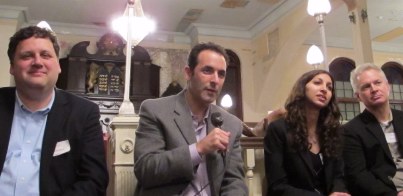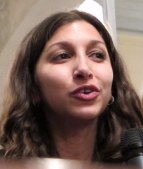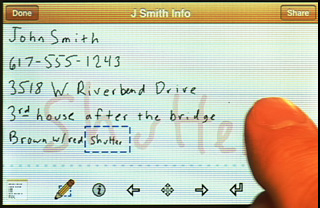danbricklin.com/log
|
||
|
|
Starting December 5, 2009
Vilna Shul panel and trying my new camera, Dan Bricklin's Note Taker for the Apple iPhone and iPod touch
05Dec09-16Dec09
2009_12_05.htm
|
|
|
Vilna Shul panel and trying my new camera [link]
Tonight was another of the wonderful Vilna Shul Speakers Series, hosted by Doug Levin. This one was "Fireside Chat with Scott Kirsner and panel on Travel and Search". It included Scott, Jeremy Wertheimer, CEO and Co-Founder of ITA Software, Mark Watkins, CEO and co-founder of Goby, and Dena Yahya, TripAdvisor Director of Revenue and Traffic Management. Unfortunately, I didn't record it for podcast and spent the time listening rather than tweeting or anything. It was pretty good. [Update: Scott posted a short report and a recording he did with his iPhone.]
I did take a few notes (using my new Note Taker iPhone app for the iPhone, of course). Dena of TripAdvisor had an interesting observation of the value of Facebook and iPhone apps to them: For engagement and for content, like reviews. I like that idea: You may use a full-screen browser for searching for hotels and vacation resorts, but you use an iPhone or social system to comment on it when you're there. Jeremy stated that anything you do repeatedly (like organize results of a search) can be taught to a computer though you may need millions of dollars. (His company does that and has that.) Mark reminded us of the acronym in the travel industry he hopes to help avoid: SNAD -- Significantly Not As Described.
This was the maiden voyage for my new camera. Here are some photos, with (from the left) Jeremy, Scott, Dena, and Mark:
    For a few years, in the "glory days" of my photo blogging, I used a Sony DSC-F717 camera. That camera had a very fast (f2.0-2.4), relatively long (5X) lens and 800 ASA sensitivity which let me do close-ups of people at events, even in low light. It also had a tiltable LCD display, so I could shoot with it on my lap or elsewhere without having the obvious "I'm pointing a camera at your face now" look. When I switched to a smaller pocket camera a few years ago I missed the good low-light close-ups and swivel back.
I thought of getting a good DSLR with a nice fast lens, but they are very expensive (for the really nice lens) and very big. Given that I want to carry lots of things on with me when I fly, and other reasons, that won't work for me. I finally found something that I think meets my needs and bought it last week. It's the somewhat bigger version of the pocket camera David Pogue liked so much in a recent NYTimes review. Both the small Canon S90 and larger Canon G11 use a generous (in the small camera world) sensor to increase the low-light sensitivity. The G11 has a flip-out screen and a 5x zoom, vs. the fixed screen, 3.7x zoom of the S90, and, at maximum zoom, the G11 has a faster lens. DPReview just posted a review today and describes it as "highly recommended" and that its "strengths are its balance between size, flexibility and image quality." It has easy to use dials and dedicated buttons for many of the settings I use.
Tonight I got to use it at an industry event. This was a good test. The lighting was pretty dark and located in a challenging place: right behind the speakers. I sat in the second row and shot looking down at the flipped-out and turned-up screen. You can see the cropped but otherwise unmodified wide angle and the zoomed photos, with lights right behind. I ran it on automatic with the "low light" setting and default exposure calculation. To do that you just turn a knob one click. That's it. You can compare these photos to a similar event with my old camera from last February. I'm pretty pleased. This will do quite well for blogging.
Dan Bricklin's Note Taker for the Apple iPhone and iPod touch [link]
I've spent the last several years working in the web and Ajax world, with most of my programming first in Perl and then later in JavaScript. The browser has been my target. With the release of SocialCalc I feel pretty comfortable that I have a good understanding of those computing mediums. I've been involved in the Open Source world, and also in the sell-direct-to-enterprise world. There are other new areas, though, that I'd like to learn about, too. I'm continuing to work on SocialCalc, but it's doesn't need me full-time.
Over the last couple of months I've been working on learning a different medium and a different business environment. In mid-September I purchased a shiny new 24" Apple iMac and an iPhone 3GS. I signed up for the Apple iPhone Developer Program. I bought some books and started doing the tutorials, step by step. I came up with the idea for an app I needed and built a prototype, then plunged in and started creating a full app that would be good for others, too.
A few days before Thanksgiving I submitted my completed app for inclusion in the App Store. It's now just been approved and you can try it. 30 years after VisiCalc shipped: Another app from me that starts out on Apple hardware.
What is it? People who know my history won't be surprised: It's for taking notes by writing on the screen with your finger. An "ink" app. Here's a screen shot:
 Photo of Dan Bricklin's Note Taker in use
I found the iPhone keyboard (and even physical keyboards on other phones) too cumbersome in many cases for quickly jotting down telephone numbers, addresses, and lists -- especially when someone else is dictating them to me or when it's too limiting being restricted to single-font characters on a keyboard word-wrapped as paragraphs. I hate having to say "wait...wait -- what was that again?" as I try to correct errors with a keyboard. Looking carefully at a touch keyboard and the data entry line takes up too much of my attention while trying to interact with someone else.
Other people are more used to watching you take written notes. Written notes have many nice properties: You can use layout and special (to you) lines, marks, and symbols to give extra meaning. Minor errors made by movement mistakes are less likely to result in data loss or incorrect data -- pressing a "6" instead of a "5" on a keyboard gives you a not-obviously wrong phone number, but writing an "S" instead of a "5" in a phone number is less of a problem.
The best way to learn about my app is to use it. If you have an iPhone or iPod touch, you can install the Lite version for free. The "full" version ($1.99 in the USA) adds some very useful features. (It eliminates the 4 page limit, and gives you a nice way to transcribe what you wrote at a later time using the on-screen keyboard and then create address book entries -- a key request from early testers.) Both versions can email a JPEG image of the page. (Emailing the image is very useful, and adds that needed viral aspect -- the free version includes a watermark with attribution.) Just search on the iTunes App Store for "Dan Bricklin". The product page on the Software Garden web site is "Dan Bricklin's Note Taker App".
I had to figure out how to deal with some major issues when I decided to create this app. The screen is very small, and the input from finger motion is too coarse to write much text in the small space of the touch screen. I decided to have you write in large letters and have my app shrink what you write into smaller ink on the page. I also had to come up with a simple way to let you write continuously yet add new ink automatically to the right of old. The editing controls I provide are pretty simple, and if you experiment with them you should be able to figure out what they do. However, with an iPhone app, many people aren't willing to spend the time to experiment. If it doesn't work the way they expect at once, they abandon the app. After all, it was either free or only a couple of dollars and they have other things to try. I decided to build a "Try It" mode into the product, so that when you first use it you get led quickly through simple versions of the interface and are introduced to the major features without throwing the whole interface at you at once. After lots of user testing I think that this mode should make it more likely that people will figure things out.
For those of you without an iPhone or iPod touch (or that hate using tutorials), you can watch a YouTube video I made that shows the product in action:
An Android version is in the works, but it's not ready yet.
So, I've learned a lot of new stuff. After having so much fun with JavaScript I had to go back to the old days of programming in verbose C-derived languages and no garbage collection (Apple's Objective-C). I had to learn a whole new API (I've never programmed the Mac except some simple HyperCard decades ago and some Perl). I've had to learn the iPhone User Interface conventions. I've also had to become quite acquainted with the App Store and the world of one and two dollar software packages in (hopefully) high volume. I've benefited a lot from the advice of others available on lots of web sites, and Apple's voluminous documentation.
When I do my consulting and providing analysis here on the web, I like to have as much hands-on experience as possible. Note Taker is giving me the opportunity to extend my experience into this new and very important world. In the process, I hope I'm also bringing a truly useful app to market, too.
|
||
|
© Copyright 1999-2018 by Daniel Bricklin
All Rights Reserved.
See disclaimer on home page.
|
||